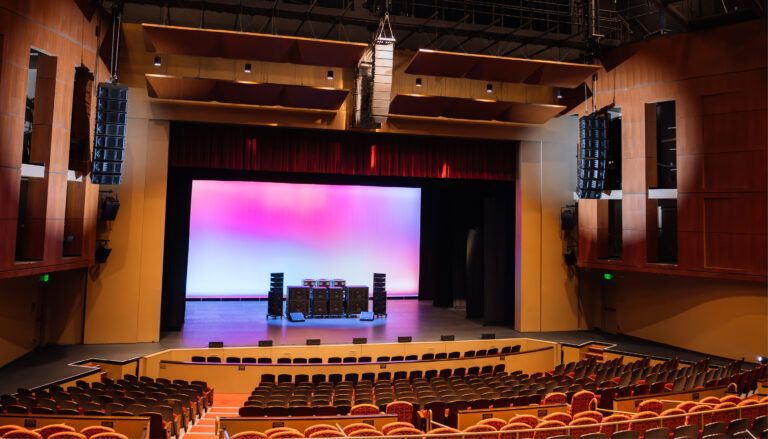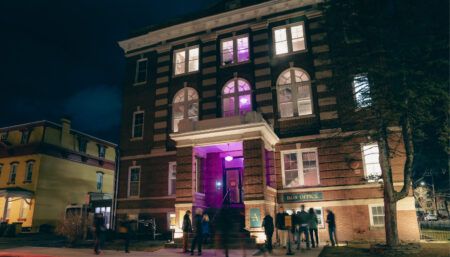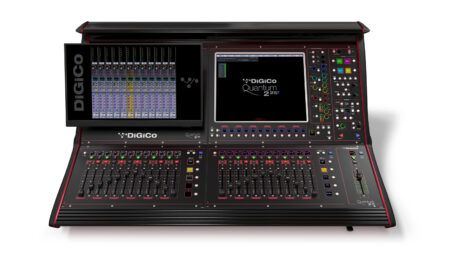A new Meyer Sound Panther system has been installed at The Gallo Center for the Arts in Modesto, California. The setup is designed to support a diverse mix of Broadway productions, symphony performances, rock concerts and corporate events.
Almost two decades since opening in 2007, the venue was ready for a new sound system capable of handling a diverse audio landscape without compromise, supporting the venue’s broad programming.
The installation, spearheaded by Bay Area systems integrator Advanced Systems Group (ASG) in collaboration with Meyer Sound’s design team, replaced the main theatre’s sound system and introduced a left-centre-right (LCR) configuration to align with the needs of touring theatre productions. The system was installed by Oakland-based Waveworks AV, led by Brad Katz and Aaron Ballard.
“The Gallo Center’s previous system wasn’t meeting performance expectations,” said Tom Menrath, audio team director at ASG, which has been a Meyer Sound collaborator for more than two decades. “They wanted a high-performance, top-level system that could suit all their clients’ needs – no questions asked.”
In 2019, ASG integrated Meyer Sound stage monitors and ground-stacked arrays in the Gallo Center, bringing in 14 MJF-210 low-profile high-power stage monitors and two arrays of four Lina very compact linear line array loudspeakers over two 750-LFC very compact low-frequency control elements for use as fills or in outside applications. “They were blown away by how great everything sounded, and the build quality,” said Menrath. “They decided at that point that they were ready to replace their entire system.”
“We knew we wanted to re-introduce having a centre cluster,” explained Jordan Lonn, the Gallo Center’s head audio engineer. “That was in the original design of the theatre, but it wasn’t implemented well and it ended up being removed.”
“With Panther, we can design a system that can seamlessly accommodate drastically different types of programming,” said Menrath. “Broadway productions demand an LCR setup, while high-impact concerts need a PA that can deliver power and punch. Panther checked every box.”
Lonn said many factors led to the decision to go with a Panther system. “If we’re putting on the phrase ‘state of the art’ with respect to our publications, we need to reflect that in our technical offerings for sound as well,” he said. “With Panther, the technology stands for itself. And with rigs going out on all these massive tours like Metallica and Ed Sheeran, we know it fulfils riders. Also, the fact that Meyer Sound is local and makes everything as much as possible in house factored heavily into our decision-making process. We don’t have to wait for overseas shipping if there’s going to be a replacement down the road.”
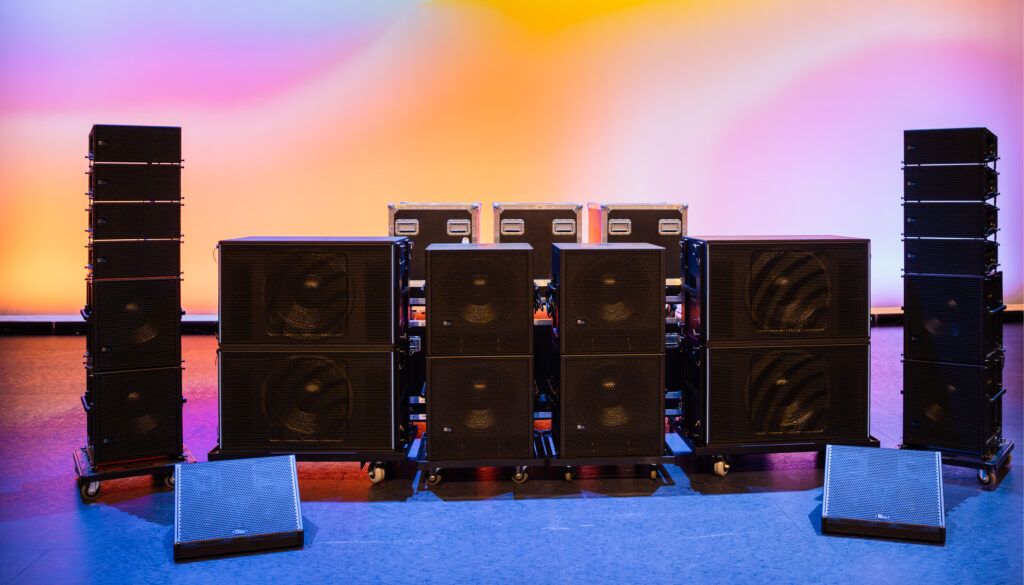
Menrath, in collaboration with Meyer Sound’s design team, specified a Panther system in Meyer Sound’s Mapp 3D system design and prediction tool, sharing the system plots with Lonn. “I got to open that file up and play around,” said Lonn. “Normally, that insight into the design isn’t necessarily on the table. They were so inviting, working with me to help me understand what they had in mind, and listening to my feedback. The proof was in the pudding, as the saying goes.”
The dynamic, modular installation centres around 16 Panther large-format linear line array loudspeakers configured in left and right main arrays, augmented by a centre cluster of 10 Leopard compact linear line array loudspeakers. A low-frequency foundation of nine 2100-LFC low-frequency control elements comprises five flown in a centre cardioid array and four ground-stacked for flexibility. Ultra-X42 and Ultra-X20 compact point source loudspeakers and UPQ-D1 full-size loudspeakers serve as side fills, lip fills, and front fills; four extra 900-LFC low-frequency control elements supplement the stage monitoring system when necessary. Everything is controlled by Galileo Galaxy 816 network processors and a Galileo Galaxy 408 at FOH.
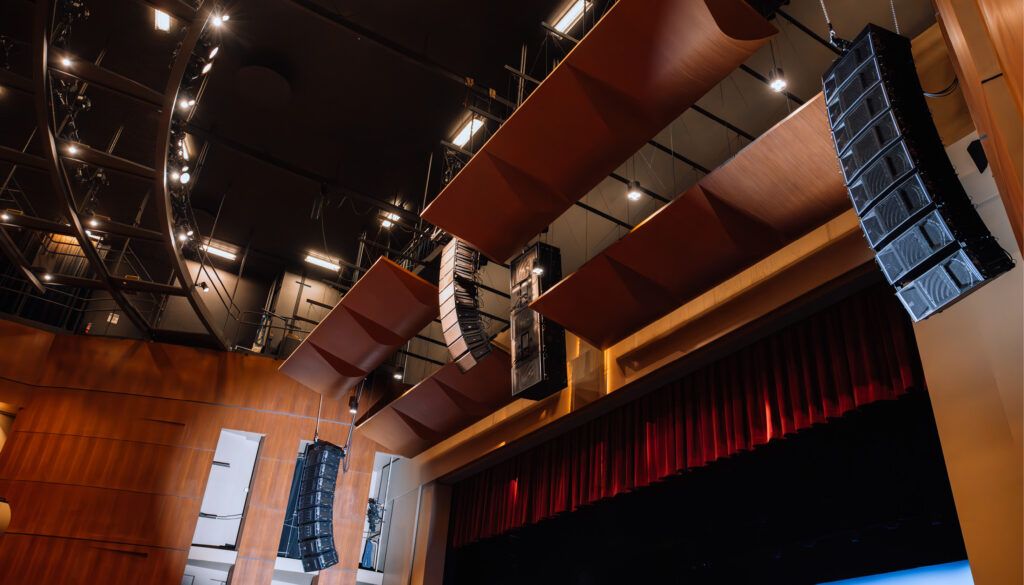
Lonn said the system delivers exactly what the Gallo team had hoped for – and more: “I’m going to say a bunch of buzzwords here, but the power and headroom are wildly impressive. The detail and stereo imaging maintains clarity, and intimacy, without needing to get louder than you need to be and yet tracks very well as you push the system for more dynamic performances.”
“I’ve been surveying every guest engineer before and after each show, and the feedback has been phenomenal – which typically never happens,” Lonn continued. “Audio engineers are fickle; I’m one, so I get it. But before they even start, they see the system, realise what they’re working with, and immediately feel relaxed. They say, ‘Okay, we’re gonna have a good day.’”
“After the show, I always ask if there’s anything they would change about the system for their mix, and across all types of productions and engineers, nobody has said they would do anything different,” he added. “That tells me the design and implementation are impeccable right out of the box. Even our board members have noticed, with one telling our CEO and passed along to our technical director of production, Jeremiah Lewis, that it was the best-sounding show they’ve ever heard, calling it – and this is a quote – ‘money well spent’.”
Lonn said the venue is considering additional Meyer Sound upgrades for its smaller second theatre: “To become a full and complete Meyer Sound house is very exciting.”


